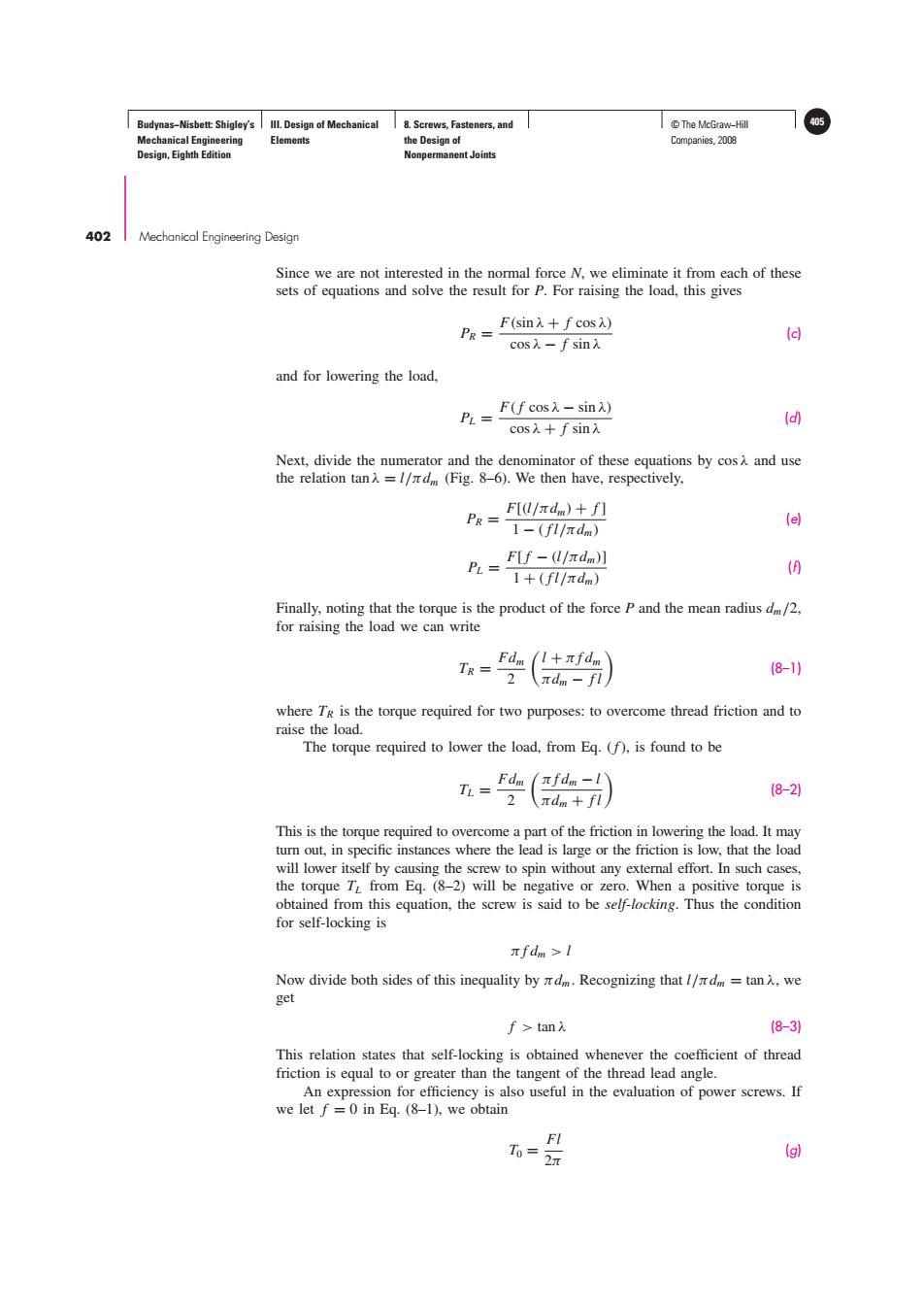正在加载图片...

Budynas-Nisbett:Shigley's Ill.Design of Mechanical 8.Screws,Fasteners,and I©The McGraw-Hil Mechanical Engineering Elements the Design of Companies,2008 Design,Eighth Edition Nonpermanent Joints 402 Mechanical Engineering Design Since we are not interested in the normal force N,we eliminate it from each of these sets of equations and solve the result for P.For raising the load,this gives F(sinλ+fcos入) PR= (d cosλ-fsinλ and for lowering the load, F(fcos入-sin) PL= (d) cosλ+fsinλ Next,divide the numerator and the denominator of these equations by cosA and use the relation tan=l/d (Fig.8-6).We then have,respectively, PR= F[(l/dm)+f] (e) 1-(fl/πdm) FLf-/πdm)】 PL= 1+(fl/πdm) (0 Finally,noting that the torque is the product of the force P and the mean radius dm/2, for raising the load we can write Fdm/l+πfdm TR= πdm-fi 8-1) 2 where TR is the torque required for two purposes:to overcome thread friction and to raise the load. The torque required to lower the load,from Eg.(f),is found to be Fdmπfdm-l\ TL=- (8-2) 2 πdm+fl This is the torque required to overcome a part of the friction in lowering the load.It may turn out,in specific instances where the lead is large or the friction is low,that the load will lower itself by causing the screw to spin without any external effort.In such cases, the torque TL from Eq.(8-2)will be negative or zero.When a positive torque is obtained from this equation,the screw is said to be self-locking.Thus the condition for self-locking is πfdm>l Now divide both sides of this inequality by rdm.Recognizing that l/ndm tanA,we get f>tan入 (8-31 This relation states that self-locking is obtained whenever the coefficient of thread friction is equal to or greater than the tangent of the thread lead angle. An expression for efficiency is also useful in the evaluation of power screws.If we let f =0 in Eq.(8-1),we obtain FI To= 2π (g)Budynas−Nisbett: Shigley’s Mechanical Engineering Design, Eighth Edition III. Design of Mechanical Elements 8. Screws, Fasteners, and the Design of Nonpermanent Joints © The McGraw−Hill 405 Companies, 2008 402 Mechanical Engineering Design Since we are not interested in the normal force N, we eliminate it from each of these sets of equations and solve the result for P. For raising the load, this gives PR = F(sin λ + f cos λ) cos λ − f sin λ (c) and for lowering the load, PL = F( f cos λ − sin λ) cos λ + f sin λ (d) Next, divide the numerator and the denominator of these equations by cos λ and use the relation tan λ = l/πdm (Fig. 8–6). We then have, respectively, PR = F[(l/πdm) + f ] 1 − ( f l/πdm) (e) PL = F[ f − (l/πdm)] 1 + ( f l/πdm) (f) Finally, noting that the torque is the product of the force P and the mean radius dm/2, for raising the load we can write TR = Fdm 2 l + π f dm πdm − f l (8–1) where TR is the torque required for two purposes: to overcome thread friction and to raise the load. The torque required to lower the load, from Eq. (f), is found to be TL = Fdm 2 π f dm − l πdm + f l (8–2) This is the torque required to overcome a part of the friction in lowering the load. It may turn out, in specific instances where the lead is large or the friction is low, that the load will lower itself by causing the screw to spin without any external effort. In such cases, the torque TL from Eq. (8–2) will be negative or zero. When a positive torque is obtained from this equation, the screw is said to be self-locking. Thus the condition for self-locking is π f dm > l Now divide both sides of this inequality by πdm . Recognizing that l/πdm = tan λ, we get f > tan λ (8–3) This relation states that self-locking is obtained whenever the coefficient of thread friction is equal to or greater than the tangent of the thread lead angle. An expression for efficiency is also useful in the evaluation of power screws. If we let f = 0 in Eq. (8–1), we obtain T0 = Fl 2π (g)��